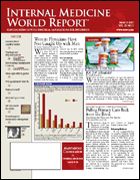Publication
Article
Internal Medicine World Report
Combination Therapy Reduces Asthma Exacerbations
Combination Therapy Reduces Asthma Exacerbations
SAN ANTONIO—The use of combination therapy with an inhaled corticosteroid
and a long-acting beta agonist has been shown superior to monotherapy in
reducing exacerbations regardless of season, according to data presented at the
American Academy of Allergy, Asthma, and Immunology annual meeting.
For this retrospective analysis, data were analyzed from four 12-week, placebo-
controlled, double-blind trials in which almost 2000 patients (aged ≥15
years; mean age, 36 years) were randomized to one of the following groups: fluticasone
propionate (Flonase), 88 ìg bid (n = 529); fluticasone propionate/salmeterol
(Advair Diskus), 100/50 ìg bid (n = 427); or oral montelukast (Singulair), 10
mg once daily (n = 954). Before randomization, all patients were symptomatic
with use of short-acting beta-2 agonist therapy alone. An asthma exacerbation was defined as
any event requiring the use of an asthma medication other than the study drug or
albuterol (Proventil). Seasons were designated as winter (January-March), spring
(April-June), summer (July-September), and fall (October-December). Results
showed that fewer exacerbations occurred in patients receiving fluticasone propionate/
salmeterol (1%) compared with fluticasone ropionate (6%) or montelukast
(7%) (Table). “There appears to be a marked difference in the rate of exacerbation, with the
combination inhaled corticosteroid and long-acting beta agonist being much more protective against exacerbations than either of the other 2 treatments. This is true for exacerbations occurring during any part of the year, although there is a suggestion that the difference is greatest in the fall, which may represent a viral season of exacerbations,” said lead investigator Harold Nelson, MD, of the National Jewish Medical and Research Center, Denver, Colo. These data suggest that treating both components of asthma (ie, inflammation and smooth-muscle dysfunction) may be more effective in reducing exacerbations than treating either component alone. “In patients who are not adequately controlled, the most effective single treatment is a combination of inhaled corticosteroid and long-acting beta agonist,” D r Nelson told IMWR. “Unfortunately, many patients with asthma who would benefit from this treatment are not receiving it, in part because it is easier to prescribe a pill as opposed to an inhaler.” Patient compliance is an issue with these medications, so physicians need to be proactive in counseling patients that fluticasone propionate/salmeterol may help lower their annual exacerbation rate compared with fluticasone propionate or montelukast alone. “If the physician
is convinced of the effectiveness of the medicne and can get that message
across to the patient, it will improve adherence. Physicians need to be more





